Letters from Lodi
An insightful and objective look at viticulture and winemaking from the Lodi
Appellation and the growers and vintners behind these crafts. Told from the
perspective of multi-award winning wine journalist, Randy Caparoso.
Is it time for a Lodi Ancient Vine Accord?
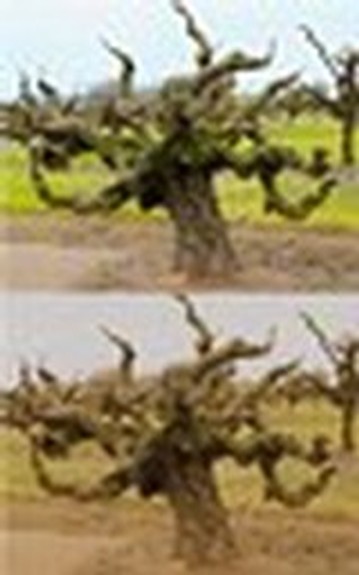
At 104 years of age, Zinfandel grown in Lodi's Soucie Vineyard fits most definitions of "ancient vine"
Let's talk about ancient vines. What's the difference between an ancient vine and an old vine? There are no official guidelines for any of those designations. The TTB, which controls the language of American wine labels, is pretty lax when it comes to this. This is good, because in our country we generally like a little bit of freedom with our commercial products, as long as we're being responsible about it.
If anything, here in Lodi, most vintners and growers go by the Historic Vineyard Society's definition of a "historic vineyard," which is a minimum of 50 years old for at least a third of a vineyard (all old vineyards consist of a good percentage of younger vines, planted to replace the original vines as they die off). This seems like a reasonable definition of "old vine" as well.
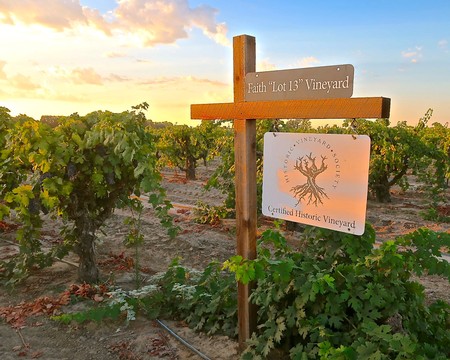
Lodi's Lot 13 Vineyard, registered as a Historic Vineyard Society-certified vineyard
Right now, in 2020, the definition of old vines as being at least 50 years ago also fits in with Lodi AVA history because the 1960s were the last decade when free-standing, spur-pruned vineyards were planted, particularly on their own natural rootstocks (for deeper reading, see our post on The past and present usages of head-trained vines in Lodi). By the late 1960s and the start of the 1970s, most new vineyards planted in the Lodi region were trellised. If there were spur-pruned, head-trained, or vertical cordon-trained vines planted after the 1960s in the old style, held up by one stake and no trellis wires, they were all grafted on top of rootstocks selected for increased production.
The 1960s, in other words, were the last of the era of spur-pruned, own-rooted vines stretching back as far as the late 1850s when European grape varieties were first planted in the Lodi wine region. Today, Lodi's oldest surviving vineyard is the Bechthold Vineyard — 25 acres of Cinsaut planted by Joseph Spenker in 1886, and still owned by Spenker's descendants.
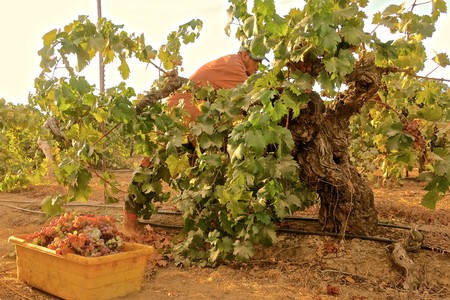
Picking Flame Tokay interplanted in Jessie's Grove's Royal Tee Vineyard Zinfandel block, planted in 1889
Bechthold Vineyard is what many locals would describe as an "ancient vine" growth — consisting of vines over 100 years old. Again, this is not an official or regulated nomenclature. It's more of an acknowledgment of a planting's age, given out of due respect. Lodi's Jessie's Grove Winery, for instance, bottles its Carignan and oldest Zinfandel block, from vines originally planted in 1900 and 1889 respectively, as "Ancient Vine" wines. They bottle their Zinfandels from their 1940s blocks as "Old Vine." That seems about right.
Interestingly, the only region in the world that we know of that has attempted to regulate the usage of wine-label terms connected to the vine age is Australia's Barossa Valley. In 2009, Barossa Valley vintners got together to establish the Barossa Old Vine Charter, which registers older vines by age in order to preserve and promote them. Their designations:
Barossa Old Vine — vines at least 35 years old
Barossa Survivor Vine — at least 70 years old
Barossa Centenarian Vine — at least 100 years old
Barossa Ancestor Vine — at least 125 years old
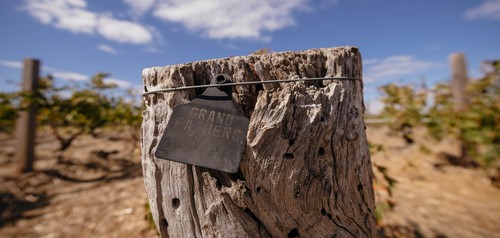
"Grandfather" vine in Barossa Valley, dating back to 1860 (image courtesy of Barossa Old Vine Charter)
Taking a cue from the Barossa Old Vine Charter, here is how vintners in Lodi may consider delineating their old vine plantings under, say, a "Lodi Ancient Vine Accord," in order to enhance the standing of these vineyards in the wine world:
Lodi Old Vine — 50 years or older
Lodi Heritage Vine —75 years or older
Lodi Ancient Vine — 100 years or older
Lodi Historic Vine — 125 years or older
There are not as many vineyards over 125 years old in Lodi as there are in Barossa Valley (where the number is currently around a dozen). However, in 6 to 20 years, well-known Lodi Zinfandel growths such as Marian's (planted 1901), Lizzy James (1904), Steacy Ranch (1907), Rous (1909), Kirschenmann and Lot 13 Vineyards (1915) would all qualify as "Lodi Historic Vine" vineyards, joining Bechthold Vineyard (1886) and Jessie's Grove's Royal Tee Vineyard (1889).
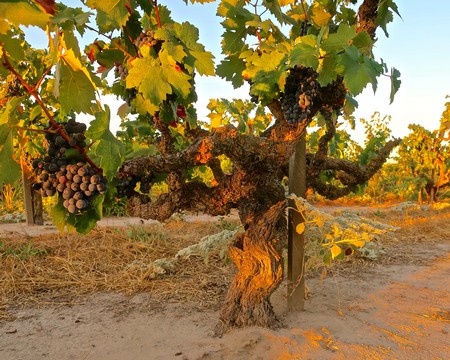
Ancient vine Zinfandel in Lodi's Marian's Vineyard, planted in 1901
What makes ancient vines so special? This past summer we asked Greg La Follette — who produces three different wines from Lodi vineyards over 100 years old under his Alquimista label — about how he felt about Lodi's most venerated plantings. He shared some thoughts straight from the heart:
Telling the story of these ancient vines is a mission of the highest order. I may be speaking from an emotional standpoint, but to speak of the merits of old vines is to speak of what is right and true and unswerving in this world. Right now, more than ever, we need the wisdom of age in this world. To respect and revere old age while celebrating youth is a part of the balance of life that these old vines speak to. This is what we all need in our lives.
The big advantage of a region like Lodi is that it not only has great growers, it has lots of old vines, and even some ancient vines planted 100 years or more ago. Older vines, like good growers who've been around a long time, know exactly what they're doing.
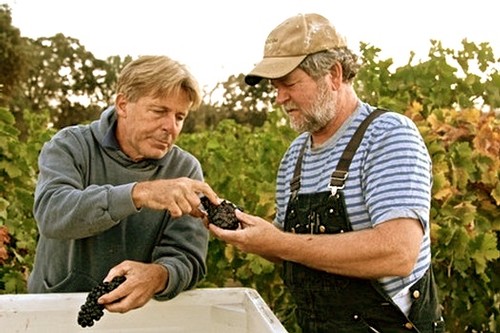
Alquimista's Greg La Follette (right) field-sorting ancient vine Zinfandel with Greg Burns, the great-great-grandson of Joseph Spenker who planted Lodi's Royal Tee Vineyard in 1889
Vines, in that sense, are like people. When they're very young they're fun and exuberant, great to have around. But you can't expect them to do any heavy lifting and they need guidance, like a child — you give them a Hello Kitty backpack and let them toddle along.
Teenagers are stronger even though they still need direction, but you can give them an REI backpack, load them up with the cans of beans and march them out on long, rigorous trails up in the Sierras. Fully mature adults know more, although they can still use a partner, or spouse, to help keep them focused.
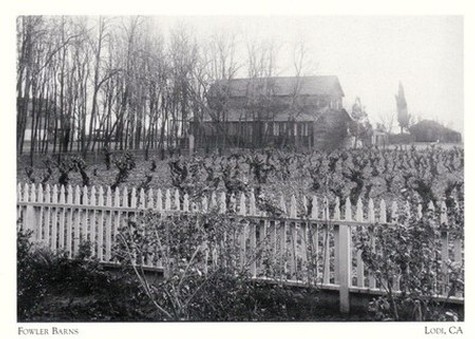
1907 postcard of old vine Lodi grown Tokay
Older people may not be as capable of carrying the heaviest loads, but at least they know who they are. The oldest vines are like that. They may not produce a lot, but what they do produce is more likely to be very, very good. During times of droughts or heavy rain, they're the ones who know what to do because they've seen it all before.
There is more grace, symmetry, and wisdom in an ancient vine — things you can't find in young vines. There is no relationship as nourishing as a relationship with an older person, just like what a winemaker finds when he partners with an older vine. Your chances of creating a great or memorable wine are that much higher. That's the beauty of a region like Lodi.
Now more than ever, old vines can teach us about our own selves, if we are only willing to listen to their voices!
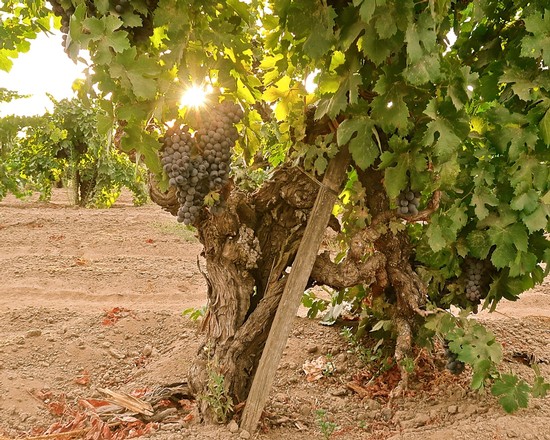
In Lodi's oldest continuously cultivated growth: Bechthold Vineyard Cinsaut, planted in 1886